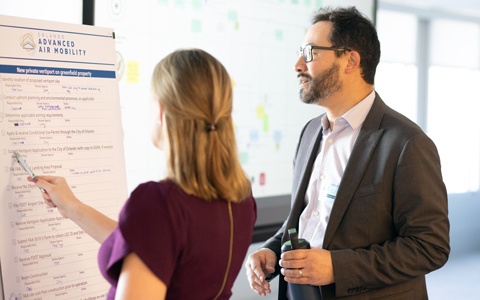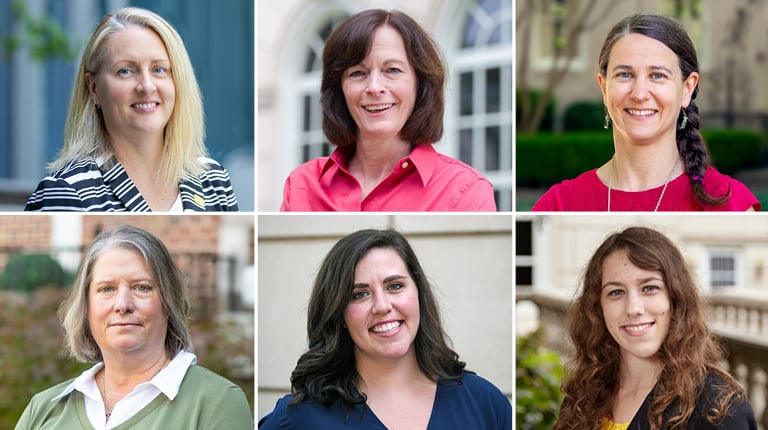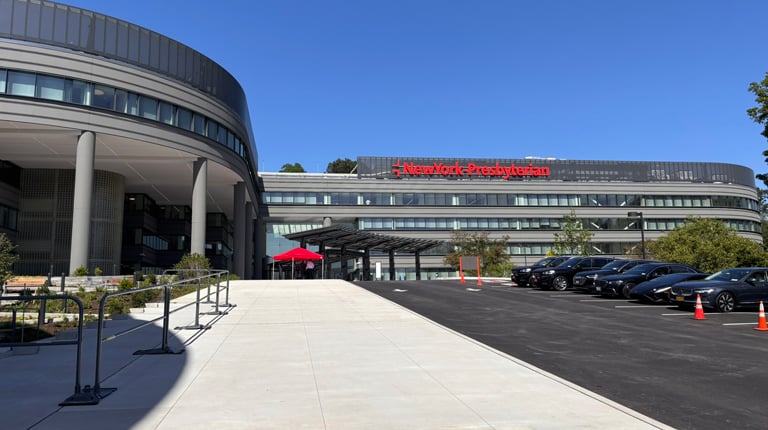
Over 100 transportation professionals, private industry representatives, and aviation stakeholders from across Florida and the U.S. recently gathered at the City of Orlando to help pave the way for advanced air mobility (AAM) via the first tabletop planning workshop for vertiports to address the implementation and regulatory framework of future electric/hybrid vertical take-off and landing (eVTOL) aircraft. VHB facilitated the event as part of its ongoing work with Orlando’s Future-Ready City Master Plan.
The vertiport workshop was attended by federal agencies and transportation industry partners, including representatives from the Federal Aviation Authority (FAA), Florida Department of Transportation (FDOT), Greater Orlando Airport Authority (GOAA), Kissimmee Airport, AAM facilitators, and the City of Orlando. Participants learned more about the emerging field of AAM, which also includes unmanned aircraft systems (UAS) such as electric drone technologies for package delivery, environmental monitoring, and emergency response. VHB aviation and transportation planners led the groups through a discussion about different vertiport planning scenarios. The information gathered at the event will help inform new vertiport standards in the City’s land development code.
“There are a number of important considerations when it comes to preparing for something as game changing as flying electric vehicles,” said Curt Ostrodka, VHB Director of Smart Communities. “We are building a common understanding of the dynamic regulatory framework at federal, state, and local levels to enable this future mode of mobility.”
Under Orlando Mayor Buddy Dyer’s leadership, the City aims to become a national leader in embracing and advancing AAM. In 2021, the City announced two partnerships—with VHB to create an AAM Transportation Plan and an exclusive aero-research partnership with NASA - National Aeronautics and Space Administration, which is helping inaugural aviation markets like Orlando to develop air transportation systems that safely move people and cargo.
While public and private companies are developing, testing and evaluating the systems and technologies needed for AAM, cities like Orlando are bringing stakeholders together to consider planning for things like air traffic density brought on by additional aircraft, ground control management, code compliance, and more.
In a recorded address, Mayor Dyer described the collaborative workshop as an important step in bringing sustainable, equitable transportation to communities.
“Orlando strives to take a lead role in understanding the role for local government in AAM and we hope to be a model city for others to follow,” said Mayor Dyer.
Kevin Thibault, Chief Executive Officer of GOAA, shared how MCO is identifying land to build a vertiport that seamlessly integrates with the airport’s expansion to accommodate Brightline high speed rail and future SunRail and light rail facilities. Mitchell Bernstein, FAA NextGen Technology Development and Prototyping Division, told participants that the FAA’s approach to AAM balances the pace of innovation with safe operation. He expects AAM to expand quickly from piloted to autonomous operations and a potential $30 billion market by 2030. Brian Stanger, PE, FDOT District 5 Modal Development Administrator, described the state’s roadmap for AAM implementation.
“Vertiports won’t just appear overnight,” said Jacques Coulon, City of Orlando Mobility Innovation Manager. “There is a lot of thought and planning going into AAM in Central Florida. Feedback we get from the workshop will inform how the City modernizes its existing code for heliports and protects public safety.”
Vertiports and airspace are subject to regulation from the FAA and FDOT, while land use is regulated by local governments. Both U.S. and international companies are investing in the technology and infrastructure to make it happen and are testing vehicles at airports like Tampa International.
Florida’s aerospace industry makes it a natural proving ground for new aviation technologies. VHB is helping steward airports and municipalities through planning using input from activities like this workshop and guidance from FDOT, FAA, industry research organizations, and local transportation providers. Energy consumption and storage is top-of-mind for the aviation industry as they adopt resiliency plans and consider the impacts that new technologies like AAM would have on electrification and hydrogen.
Learn more about VHB’s integrated approach to advancing new technologies like AAM.


